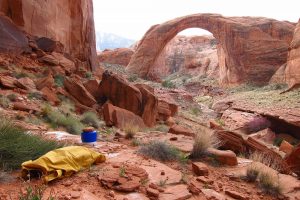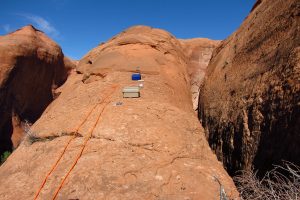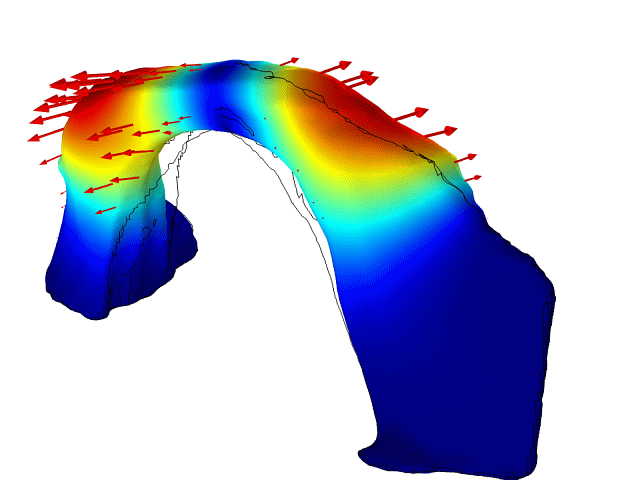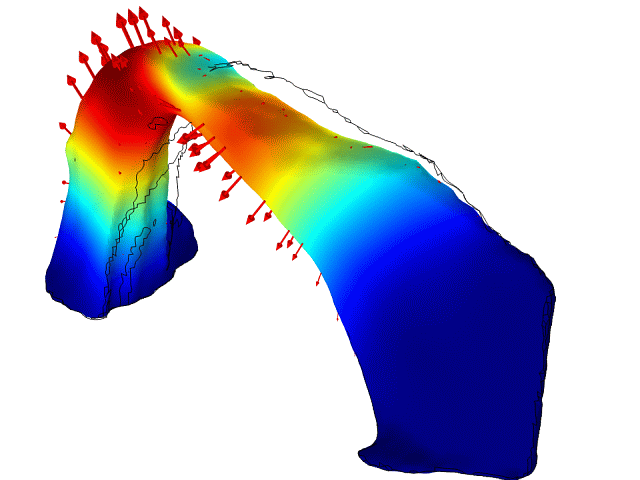21 September 2016
Human activities rattle natural rock of Utah’s Rainbow Bridge
Posted by dgaristo

Reference seismic sensors, protected from the sun by a water cooler. Rainbow Bridge is in the background. Credit: Jeff Moore
By Paul Gabrielsen
Utah’s iconic Rainbow Bridge hums with natural and man-made vibrations, according to a new study accepted for publication today in Geophysical Research Letters, a journal of the American Geophysical Union. The study found both natural waves in Lake Powell and induced earthquakes in Oklahoma cause the rock bridge to vibrate at different resonant frequencies. The vibrations are small, according to the study’s authors, but the study provides a baseline measure of the bridge’s structural integrity and shows how human activities can rattle solid rock.
“Rainbow Bridge is constantly on the verge of stability,” said Jeffrey Moore, assistant professor of geology and geophysics at the University of Utah in Salt Lake City and lead author of the new study. “It’s at this delicate balance, and it’s worth trying to understand what forces play a role in accelerating the demise of such sensitive and exceptional natural features.”
Listening to the bridge
Rainbow Bridge, located in southern Utah, is a sandstone formation arching over a side canyon of the Lake Powell reservoir. At nearly 300 feet from the canyon floor to the apex of the arch, Rainbow Bridge is one of the highest natural bridges in the world. The site is also revered as sacred by five nearby Native American nations and visitors are asked not to walk under the bridge out of respect.
With permission from tribal groups obtained by the National Park Service, Moore and his team monitored Rainbow Bridge to determine its modes of vibration, or predominant movements that together make up the vibration of the bridge. “A mode is the pattern of vibrational motion at a given frequency,” Moore said. “Think of a guitar string. When you pluck a guitar string you generate one main tone plus several overtones on top of that. Those are all different modes.”
Sounds of vibrations of Rainbow bridge during gusts of wind, sped up 50 times.
Credit: Jeff Moore.
 He and his team placed two seismic sensors on the bridge and two at a nearby location for reference comparison. Moore had conducted similar studies on other rock arches, seeking to understand how arches vibrate and what kinds of vibrational energy can cause resonance in the rock structures.
He and his team placed two seismic sensors on the bridge and two at a nearby location for reference comparison. Moore had conducted similar studies on other rock arches, seeking to understand how arches vibrate and what kinds of vibrational energy can cause resonance in the rock structures.
All objects, including buildings, bridges, and rock arches, resonate at preferred frequencies. If an object feels vibrational energy at its resonant frequencies, then the motion of the object amplifies the vibrational waves – sometimes to the point of damage. Resonant frequencies are well-known for man-made objects, but are more difficult to calculate for natural structures, such as Rainbow Bridge.
The team recognized the rare opportunity to study the revered site. “We had a real respect for the bridge and the access we were permitted,” Moore said.
Catching the waves
Over two days of seismic monitoring in March 2015, the team identified eight major modes of resonant vibration – some forward and back, some up and down, and some twisting. Overall vibration of the bridge was a combination of those modes. Most of the time the bridge just shivered at a low hum.
A GIF depicting one of the vibrational modes of Rainbow Bridge (Mode 1).
Credit: Jeff Moore.
Several human-caused events contributed to resonance, however. Mode 1, for example, a forward and back bending motion, resonates at a frequency of around 1.1 Hertz – about the same frequency as the waves of Lake Powell. Vibrations from those waves travel through the rock and are felt in Rainbow Bridge.
The bridge also feels earthquakes. During the study period, the team recorded three earthquakes. Two of the earthquakes were local, but one, likely an induced earthquake, occurred in Oklahoma, more than 1,600 kilometers (1,000 miles) away – a testament, Moore says, that human activities can have unanticipated consequences.
Sounds of vibrations of Rainbow bridge due to a local earthquake (the thunderclap at about 0:24), sped up 50 times.
Credit: Jeff Moore.
“Many things we do are actually felt by Rainbow Bridge, which is extremely remote,” he says. “Human activity has altered the earth’s vibrational wavefield.” It’s unclear what effect these low-level vibrations have on sensitive structures, or how they compare with natural vibrations caused by forces such as wind. “Recording that is an interesting outcome,” Moore says.
A GIF depicting a second vibrational mode of Rainbow Bridge.
Credit: Jeff Moore.
Future directions
While Moore’s team conducted seismic monitoring, Jack Wood of the National Park Service took photos of the bridge from countless vantage points, allowing the team to construct a 3D model of Rainbow Bridge that can be viewed here.
From the model, the researchers were able to estimate the weight of the bridge at around 110,000 tons. According to Moore, that’s about the same as a Nimitz-class aircraft carrier or a large cruise ship.
A GIF depicting a third vibrational mode of Rainbow Bridge.
Credit: Jeff Moore.
Moore says the team’s work is an impetus for further study of Rainbow Bridge, since so little is known about how vibration and resonance affect the health of the bridge. A repeated experiment would allow for comparison of the bridge’s vibrational modes with the baseline established in this study as a way to assess whether the bridge is undergoing changes.
“We hope to provide a new way for people to look at the bridge as a dynamic, lively feature that’s constantly vibrating and constantly moving,” Moore says. “You get a new understanding of the bridge as a living feature rather than a static structure.”
—Paul Gabrielsen is a science writer at the University of Utah. This post originally appeared as a press release on the University of Utah website.














 GeoSpace is a blog on Earth and space science, managed by AGU’s Public Information staff. The blog features posts by AGU writers and guest contributors on all sorts of relevant science topics, but with a focus on new research and geo and space sciences-related stories that are currently in the news.
GeoSpace is a blog on Earth and space science, managed by AGU’s Public Information staff. The blog features posts by AGU writers and guest contributors on all sorts of relevant science topics, but with a focus on new research and geo and space sciences-related stories that are currently in the news.